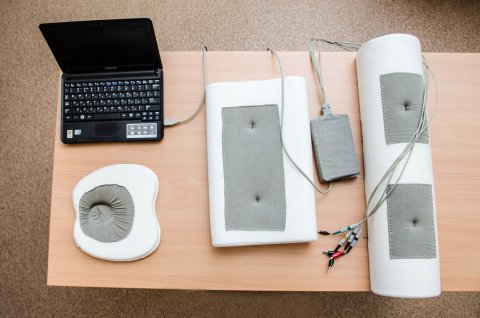At present, an innovative device, ECG-pillow, is being tested at an intensive therapy unit of one of the Chelyabinsk hospitals which would allow to perform ECG screening of the condition of bed-case patients and disabled people, as well as of newborn babies. The authors of this innovation are a team of scientists of the Institute of Sport, Tourism and Service at South Ural State University.
For three years now, a team of scientists under supervision of Vladimir Kodkin, Doctor of Engineering Science, Professor at the ISTiS Department of Physical Education and Health, has been working on creating modern devices using a unique technology of non-contact electrocardiogram tracing. One of such devices is an orthopedic pillow with an in-built ECG monitoring system.
“At present orthopedic memory pillows are in very big demand at our hospitals. Most often such pillows are a necessity for patients with limited physical capacity to move around, that is bed-case patients. So, we came up with this idea: what if we could combine a pillow and a system for functional state monitoring?” says Vladimir Kodkin.
.jpg)
A pillowcase of such a pillow is made of special electrically conductive fabric with silver-plated fiber, to which graphene fibers are planned to be added in the future in order to enhance its conductivity. The scientists from South Ural State University are testing this innovation device at the intensive therapy unit of the Regional Children’s Hospital. The obtained results already allow us to speak of high efficiency and big potential of such diagnostic devices. “Rosava” Trading Company acts as a partner in this research. Besides the pillow for bed-case patients, a pillow for newborns is also being designed.
“Since babies move all the time, it is quite a problem to do electrocardiogram screening on them. Our pillow can help you do it: you won’t have to put electrodes on a baby’s arms – it is enough that its head touches the pillow,” explains Vladimir Lvovich.
Vladimir Kodkin developed a special computer program for this research. But since the non-contact method produces a non-standard ECG signal, doctors and physiologists will have to learn to read it.
“Based on such pillow a device for monitoring and prevention of sudden infant death syndrome in the first year of babies’ life may be developed, which would allow to automatically assess heart rhythm status. We are very interested in this invention, and an agreement has already been signed on collaboration of SUSU with the Ural Research Institute for Maternity and Infanthood Protection at the Russian Federation Ministry of Health, as well as with the Ural State Medical University, the latter two will take on the medical part of the research,” comments Doctor of Sciences (Medicine), Professor Pavel Tsyvian, who is also the Head of the Department of Hominal Physiology at the Ural State Medical University, the Head of the Central Research-and-Development Laboratory at the same university, and a lead researcher at the Research Institute for Maternity and Infanthood Protection.
Another field where the SUSU scientists are using the system of non-contact electrocardiogram tracing is working with athletes. A special T-shirt was created for them made of the same electrically conductive fabric with in-built electrodes. The papers on heart rate variability of athletes published earlier described heart rate assessed without loads. The experiments by the scientists from South Ural State University show that using a non-contact ECG T-shirt, you can monitor how a person works out under load, how his or her heart rate variability changes, you can trace the variability character and see what is happening to body when it relaxes. This allowed the scientists to come up with certain hypotheses of human heart behavior under load.
“After a work-intensive phase athletes normally undergo a recovery period, during which medications are frequently used,” elaborates Vladimir Kodkin. “In order to prevent severe recovery process, you may, using our device, monitor the electrocardiogram readings already during the training period. It will allow to timely advise an athlete on when it is better to take a short break, lower load or tempo, or at which exact moments the fatigue is the highest. This will help reach the best results in sports, as well as prevent health problems.”
Today, the SUSU Institute of Sport, Tourism and Service is developing various programs on launching non-contact ECG T-shirts into mass use. Also, the scientists are working on wireless communications, what requires implementation of certain technical innovations.
“Analogous developments already exist around the world,” admits Vladimir Lvovich. “In the USA, for instance. However, in the American version only such parameters as heart rhythm and rate are monitored. These readings may be obtained with a common heart-rate monitor. Our device is an improved variant which deals with a wider complex of human health status parameters.”
Now the scientists of this major Russian university are developing a program which will be analyzing the status of human health and advising on optimizing it, for instance: “take a break”, “consult a doctor”, and so on. The joint work with the Chelyabinsk Regional Hospital will undoubtedly provide the required data for further scientific innovations.




